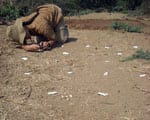National Geographic online is featuring the archaeology research of SMU Ph.D. candidate Metin I. Eren.
In the September 29 story, “Trampling Skews Artifact Dates by Thousands of Years? Animals push human tools into ground — and back in time, study says,” journalist Ker Than writes about Eren’s research in India, which found that animals trampling wet ground can alter how a scientist interprets an archaeological site.
Stone tools at a site can be pushed as much as 8 inches deep into the ground, potentially altering the interpreted age of a site as much as thousands of years, says Eren, who was part of a team of researchers that carried out the study.
EXCERPT:
Ker Than
for National Geographic News
Around the world, the hooves of water buffaloes, goats, and other large animals may have propelled countless Stone Age artifacts back in time, at least as far as archaeologists are concerned.In wet areas, wild or domestic animals’ heavy footfalls can push stone artifacts deep into the ground, making them seem older than they really are — in some cases, thousands of years older — according to a new study.
Scientists often date artifacts of the Stone Age, which began about two and a half million years ago, based on the depths at which the items are found: The deeper the object, the older it is, generally speaking.
There are other methods to date artifacts, but many rely on elements not found in stone — such as carbon.
“We can only do carbon dating on organic material that is associated with the stones,” said study author Metin Eren, an archaeologist at Southern Methodist University in Dallas, Texas.
So if a stone artifact is next to a twig, for example, Eren said, “we’ll date the twig and just assume that the artifact is also that age.”
But in the new study, published in the Journal of Archaeological Science, Eren and his team show at least one way this method can lead to false ages for artifacts.
Mud Makes Data Go Soft
Archaeologists have long known that animal trampling can reorient artifacts — sometimes long after humas have left a site — and several trampling experiments have been performed on dry ground.
Other coverage:
National Science Foundation
Physorg.com
ScienceDaily.com
RedOrbit.com
 National Geographic online features the archaeology research of SMU graduate student Metin I. Eren.
National Geographic online features the archaeology research of SMU graduate student Metin I. Eren.

